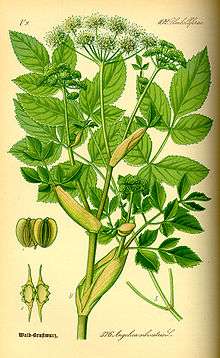Angelica sylvestris
| Wild angelica | |
|---|---|
 | |
| Scientific classification | |
| Kingdom: | Plantae |
| (unranked): | Angiosperms |
| (unranked): | Eudicots |
| (unranked): | Asterids |
| Order: | Apiales |
| Family: | Apiaceae |
| Genus: | Angelica |
| Species: | A. sylvestris |
| Binomial name | |
| Angelica sylvestris L. | |
Angelica sylvestris or wild angelica is a species of plant, an umbellifer, that grows about one to two and a half metres tall.[2]
Distribution and habitat
The species is native to Europe and Asia and grows in fields, hedgerows, open woods, marshes and fens. Woodlands, dappled shade, shady forest margins, rarely in deep shade. Will grow in light (sandy), medium (loamy) and heavy (clay) soils. Angelica proliferates in acid, neutral and basic (alkaline) soils. It can grow in full shade (deep woodland) semi-shade (light woodland) or no shade. It can be found in dry or wet habitats but prefers moist slopes. Wild Angelica grows on grazing grounds, cultured land and along streams.
Ecology
It has recently been determined to be an invasive weed in New Brunswick and Cape Breton, Nova Scotia, Canada. "According to the New Brunswick Invasive Species Council, unless this species is controlled, Woodland Angelica could spread throughout Canada, overwhelming other vegetation."[3][4] The flowers are visited by a wide array of insects and are thus characterised by a generalised pollination system.[5]
Adult wasps of the Dolichovespula norwegica wasps are known to feed off the nectar provided by A. sylvestris. [6]
Uses
It was used as a vegetable until the 20th century. The plant prevents scurvy, and it can be stored. The stem was eaten fresh, and the leaves could be boiled to a stew for storage. It could later be cooked up with milk into a tasty dish. The plant has also been used for dyeing.
Angelica sylvestris roots have been used in the traditional Austrian medicine internally as tea or tincture for treatment of disorders of the gastrointestinal tract, respiratory tract, nervous system, and also against fever, infections, and flu.[7]
Gallery
-
plant
-

-
leaf
-

-
stem
-

flowering umbel
-
-
leaf
-
leaf Cross section
-

leaf Cross section (sketch)
-

inflorescence
References
- ↑ Lansdown, R.V. (2014). "Angelica sylvestris". IUCN Red List of Threatened Species. Version 2014.1. International Union for Conservation of Nature. Retrieved 30 June 2014.
- ↑ "Woodland Angelica - Angelica sylvestris".
- ↑ https://web.archive.org/web/20110927054751/http://www.natureconservancy.ca/site/News2?page=NewsArticle&id=13554&news_iv_ctrl=0&abbr=at_ncc_. Archived from the original on September 27, 2011. Retrieved August 4, 2011. Missing or empty
|title=(help) - ↑ http://www.nbisc.ca/Species/Angelicasylvestris.html
- ↑ Van Der Kooi, C. J.; Pen, I.; Staal, M.; Stavenga, D. G.; Elzenga, J. T. M. (2015). "Competition for pollinators and intra-communal spectral dissimilarity of flowers" (PDF). Plant Biology. doi:10.1111/plb.12328.
- ↑ "Dolichovespula norwegica". Ecology of Commanster. Archived from the original on 2014-10-06.
- ↑ Vogl, S; Picker, P; Mihaly-Bison, J; Fakhrudin, N; Atanasov, A. G.; Heiss, E. H.; Wawrosch, C; Reznicek, G; Dirsch, V. M.; Saukel, J; Kopp, B (2013). "Ethnopharmacological in vitro studies on Austria's folk medicine--an unexplored lore in vitro anti-inflammatory activities of 71 Austrian traditional herbal drugs". Journal of Ethnopharmacology. 149 (3): 750–71. doi:10.1016/j.jep.2013.06.007. PMC 3791396
 . PMID 23770053.
. PMID 23770053.
| Wikimedia Commons has media related to Angelica sylvestris. |
